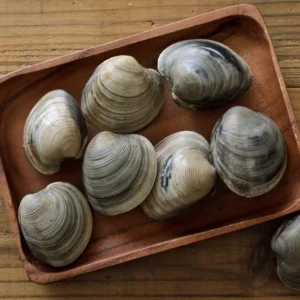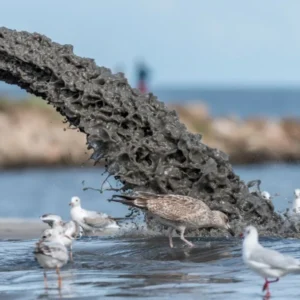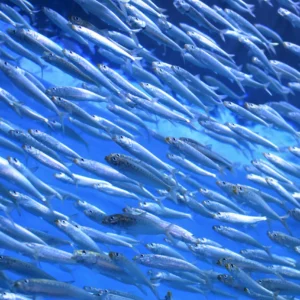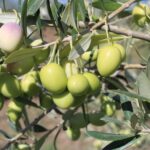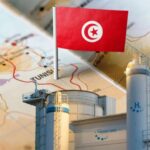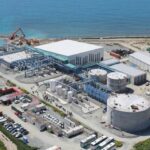The Mediterranean is warming faster than the global average. Drought, fires and soil loss are accelerating, and coastal communities are already paying the price. A bold idea is gathering shape: a continuous belt of native trees and woodlands stretching from Portugal to the Levant designed to buffer heat, anchor soils, and stabilise rural economies. At the height of the 2023 heatwaves, thermometers in Valencia and Agadir leapt to brutal new records. On the water, an enclosed, shallower mare nostrum trapped warmth; on land, brittle hillsides flashed to flame. Scientists had warned that the basin was heating about 25% faster than the world average and summers even faster than that. The warning has become a brief.
The case for a Green Barrier
In a world growing hotter day by day, the Mediterranean has emerged as a critical battleground in the fight against the climate crisis. The Mediterranean region faces an especially acute climate crisis, warming 25% faster than the world average, with summer temperatures rising 40% more rapidly.1 In recent years, this accelerated warming has driven increasingly severe and frequent heat waves, droughts, and wildfires across the basin. The summer of 2023 was particularly alarming: June shattered historical heat records, only to be surpassed by July, and subsequently by August’s extreme temperatures in cities like Valencia (46.8oC on August 10) and Agadir (50.4oC on August 11).2
Given the Mediterranean’s shallow and semi-enclosed nature, the mare nostrum is at an elevated risk for increasing sea temperatures, posing danger to its aquatic ecosystems and the communities relying upon them. Also these alarming trends and the risk of breaching the Paris Agreement’s 1.5oC temperature target well ahead of projections, it becomes increasingly urgent to initiate ambitious, collaborative projects across the Mediterranean centered around our collective battle for a resilient and sustainable ecosystem.
In 2007, the African Union adopted a bold plan to bisect the Sahel region with a “Great Green Wall”, aiming to halt desertification in its tracks by creating a contiguous strip of greenery just south of the Sahara. According to the Panafrican Agency for the Great Green Wall, the project achieved 17.8% completion as of 20203, with the aim of restoring 100 megahectares (1 million km2) of greenland, sequestering 250 Million tons of Carbon, and creating 10 million green jobs.4 However, the future of this project is dubious, with reports of survival rates of planted biomass being inflated,5 not to mention the significant regional instability following military coups in Mali, Burkina Faso, and Niger, and ongoing conflicts in Sudan. Nonetheless, this pilot program has shown the feasibility of implementing ambitious transnational projects.
Mediterranean Barrier: A Vision for the Mediterranean
Inspired by the Great Green Wall of Africa, a similar initiative is envisioned for the Mediterranean basin, encompassing regions from southern Europe (including Greece, Italy, and the Iberian Peninsula, as well as the Provence region of France and the Adriatic coast), to North Africa (Tunisia, Algeria and Morocco north of the Atlas mountains) and the eastern Mediterranean (southern Anatolia, the Levant, and the coast of Libya and Egypt).

This Green Barrier for the Mediterranean would create a contiguous belt of indigenous vegetation consisting of restored and protected forests and woodlands, wrapping around the Mediterranean Sea, creating a buffer against desertification and soil degradation, thereby mitigating the effects of climate change.
Planting indigenous and endemic species can combat past and ongoing desertification by restoring soil quality, enhancing water retention, and regulating the surrounding climate. Such trees and shrubs improve soil structure and aeration, preventing its erosion, boosting its nutrient content, and creating a more resilient environment. Furthermore, by providing shade and increasing moisture levels through transpiration, these plants naturally cool the environment, reducing evaporation rates and stabilizing local microclimates. This Green Barrier would revitalize and protect the ancient ecosystems of the Mediterranean basin, which have been vital for the coastal communities of North Africa and Southern Europe for millennia, and are threatened with climate-based disruption and even collapse.
According to the Food and Agriculture Organization (FAO) up to 30% of Mediterranean semi-arid land is now affected by desertification, with a loss of up to 7.4% of GDP due to land degradation.7 Specifically, countries with pre-existing food insecurity are most vulnerable to agricultural devastation due to environmental degradation, as evidenced by a stark decline in animal husbandry in Tunisia and Morocco (-35%) and cereal production in Jordan and Syria (-40%) as of 2020.8 Establishing a green barrier can help mitigate these effects, restoring moisture to arid lands, thus reversing desertification and contributing to the stabilization of rural economies and sustainability of future economic growth.
What to plant and what to avoid
While overall forest cover around the Mediterranean has been slowly and steadily increasing over the past 25 years, this has not been uniform when comparing its northern and southern shores. Not only is reforestation lagging behind significantly in drier areas of the basin, but forested areas are becoming increasingly threatened by overexploitation, increasing temperatures and aridity. These factors could lead to the collapse of Mediterranean forest ecosystems as coastal tree and shrub species fail to adapt to increasing temperatures, paving the way for smaller and drier grass species that exacerbate the risk of wildfires.
Similarly, slow-growing indigenous tree species like olive trees and cork oaks are gradually being replaced by imported species that pose problems to sustainable development. Eucalyptus for example, while known for its fast growth, is a highly flammable and hot-burning tree due to the high oil content in its leaves and bark.9 Furthermore, its shallow root system and large canopy outcompete native species, while failing to restore soil aeration or water retention.10
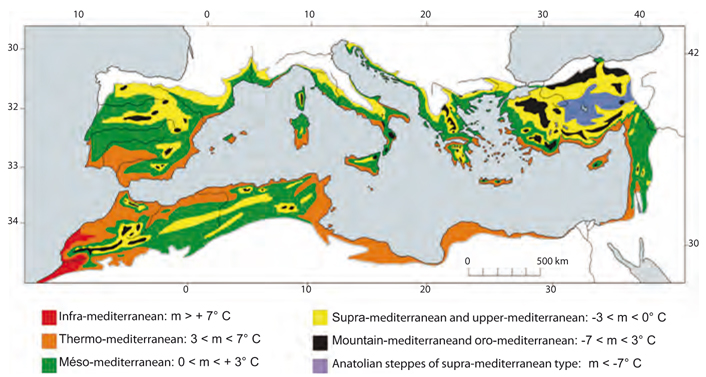
The proposed Green Barrier for the Mediterranean must therefore adopt a comprehensive strategy that prioritizes the planting of native and endemic species. These species are uniquely adapted to the region’s rocky soils and harsh climatic conditions, with deeper root systems that improve soil structure, enhance moisture retention, and reduce erosion. By focusing on native vegetation, the Green Barrier can help restore and protect Mediterranean ecosystems, ensuring their resilience in the face of ongoing climate change.
The map below shows the 27 ecological regions of the Mediterranean Basin, each defined by its unique indigenous species and ecological characteristics. Native species in these regions are crucial given their natural adaptation to the local climate and environmental conditions, making them more resilient to the impacts of climate change and more effective in stabilizing ecosystems, improving soil health, and enhancing water retention.
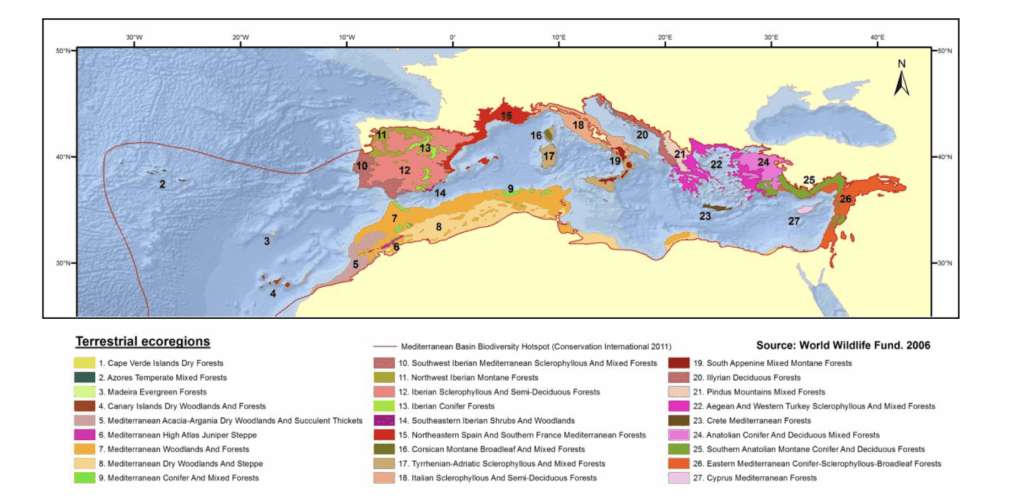
Olives, carobs, and cork oaks, for example, are three well-adapted native trees of the Mediterranean basin, requiring little water and able to thrive in the rocky and calcareous soils of the region. They also provide three high-value crops that support local economies and can be processed into a huge number of high-revenue-generating products. Carob is especially valuable thanks to its dual nature as feed for livestock and as a high-value good on both international health-food markets and domestic consumption markets. Cork can also play a significant role economically, thanks to its versatility of use and perpetual high demand, and environmentally, thanks to its strong potential for carbon sequestration. Given that cork oaks store carbon in the bark, which is harvested every 10-15 years, a harvested cork oak absorbs 3-5 times as much carbon as a wild, unharvested one.12 Specifically, for every ton of cork that is harvested, the cork oak fixes 18 tons of carbon dioxide from the atmosphere.13 As such, cork is not only a renewable resource that can easily be exported, but it is also a strong tool in the fight against climate change.
Portugal has long been the primary producer of cork products, with North African cork production falling for over a century due to the destruction of natural cork woodlands in favor of agricultural land.14 There is great potential for the revitalization of cork oaks in North Africa, supplying stable economic stimulus to rural communities relying on agriculture. Tunisia and Algeria specifically have a valuable opportunity to restore historical cork forests, especially in the northern strip of temperate land between the cities of Algiers and Bizerte. Cooperation and knowledge sharing between countries with shared ecological areas can accelerate forest restoration and facilitate the implementation of revitalization efforts.

Lessons from Africa’s Great Green Wall and Algeria’s Green Dam
In fact, cooperation between different Mediterranean countries is the single most important requisite for the realization of any such restoration effort. While there has been a gradual increase in Mediterranean forest cover in recent years, thanks to respective national action programs, the true potential of these initiatives lies in coordinated, cross-border collaboration and information and capacity sharing. Algeria, for example, successfully restored almost 53.000 hectares out of the 80.000 planned by 2030 since joining the 2017 Agadir Commitment, which aims to reforest 8 million hectares of Mediterranean forests. These projects have contributed to the Algerian Green Dam, a project instituted in the 1960s to halt the northward advancement of the Sahara.
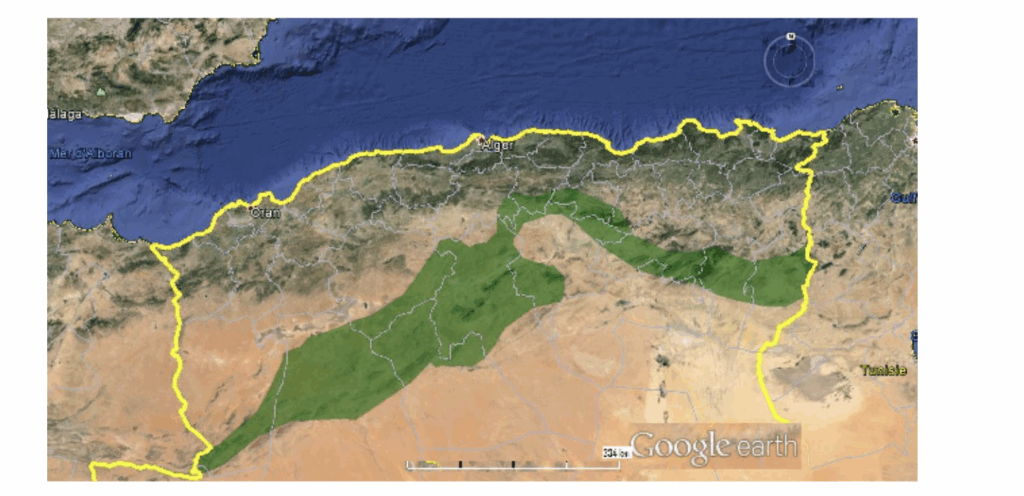
Nonetheless, these projects have largely failed to consider forestry expertise to ensure the planting of appropriate and resilient species, instead planting the slow-growing and hotly burning Eucalyptus.16 Additionally, much can be learned from Algeria’s project, including its failure to include local communities, herders, and farmers in the planning or implementation of the project, instead resorting to resources from the national armed forces.
Cork, revived and shared
Portugal dominates cork today, but historic cork forests once stretched across North Africa. Restoring them especially in the temperate belt between Algiers and Bizerte is a rare triple win: carbon storage, wildfire moderation (open, managed cork landscapes resist crown fires), and steady rural revenue from regular harvesting and value-added products. With knowledge-sharing across shared ecoregions, Tunisia and Algeria could rebuild a climate-smart cork economy in a decade.
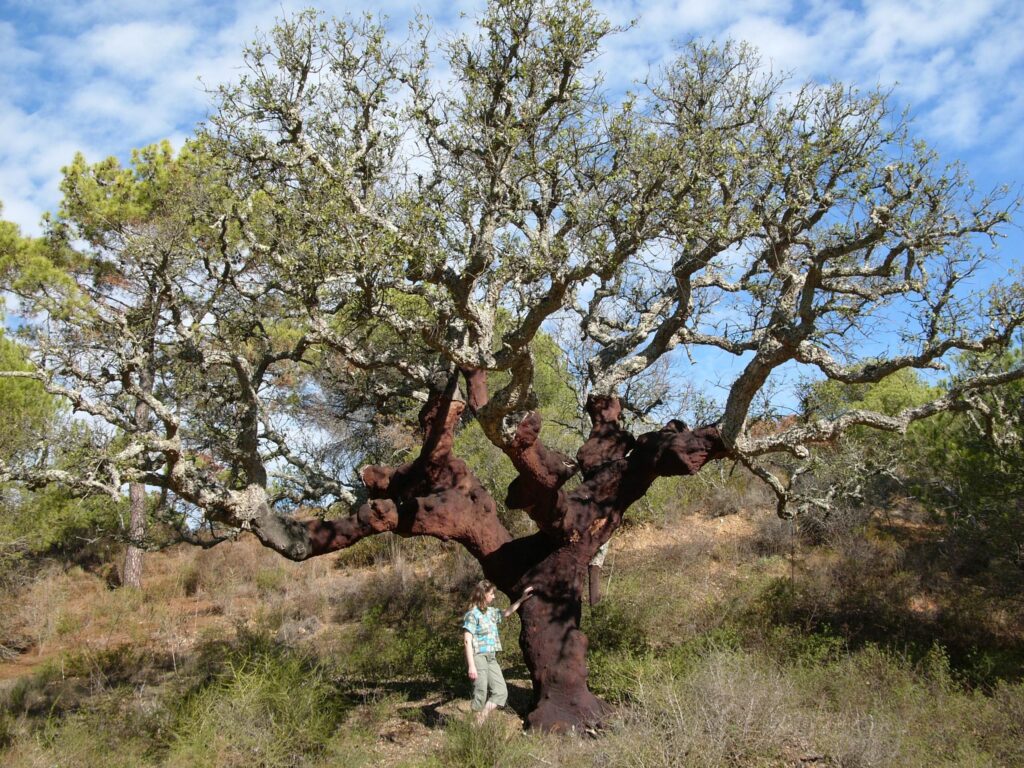
Forest diplomacy: who convenes, who pays
Considering the similarities in the climates and ecological biomes of northern Algeria and Tunisia, there is a high value to knowledge sharing and practical cooperation between the two nations to extend the Algerian Green Dam into Tunisia and beyond. This highlights the concept of forest diplomacy, coined by former French ambassador and expert in cross-Mediterranean relations Bernard Valero to describe the necessity of engaging a unified Mediterranean front on “a trajectory of innovative cooperation”.18 A basin-wide Barrier demands real cross-border cooperation not just MoUs. The region already has platforms: the Union for the Mediterranean (UfM), FAO/Silva Mediterranea, the International Association for Mediterranean Forests, and Interreg Euro-Med.
The 8th Mediterranean Forest Week (8MFW), which took place in November 2024 in Barcelona, served as a pivotal platform for advancing forest restoration and sustainable management across the Mediterranean region. Organized by the Food and Agriculture Organization (FAO), the European Forest Institute Mediterranean Facility (EFIMED), and the Joint Organizing Committee, the event brought together policymakers, researchers, and stakeholders to address the escalating threats facing Mediterranean forests, including wildfires, biodiversity loss, and climate change impacts. medmodelforest.net A significant outcome of the 8MFW was the proposal for a new Mediterranean Forest Initiative. This initiative aims to enhance regional cooperation and implement innovative strategies for large-scale forest restoration, aligning with global commitments such as the UN Decade on Ecosystem Restoration and the Bonn Challenge. The initiative seeks to promote an enlarged partnership among Mediterranean actors, focusing on preserving and restoring forest landscapes to increase resilience against climate change and other environmental challenges.
The event also highlighted the importance of integrating youth engagement in forest management. The newly launched Mediterranean Youth Task Force (MYTF) was emphasized as a critical component in fostering the next generation of forest stewards. Discussions underscored the need to provide youth with opportunities for participation and leadership in forest-related initiatives, ensuring the sustainability of restoration efforts. Furthermore, the 8MFW facilitated the sharing of successful restoration practices and adaptive management strategies. Sessions focused on community engagement, wildfire prevention, and the implementation of nature-based solutions, offering valuable insights for scaling up restoration efforts across the region. In summary, the 8th Mediterranean Forest Week was instrumental in fostering collaboration, proposing actionable initiatives, and emphasizing the inclusion of youth in forest restoration efforts. The outcomes of the event are expected to significantly contribute to the resilience and sustainability of Mediterranean forest ecosystems in the face of ongoing environmental challenges.
How to build the Barrier (a 12-point playbook)
- Map first, plant second. Use ecoregion maps to set species lists and avoid maladapted plantings.
- Seed sovereignty. Fund regional native seed banks and local nurseries; certify provenance.
- Community contracts. Co-design with farmers, herders and women’s cooperatives; pay for participation and stewardship.
- Agroforestry corridors. Stitch woodlands to farms with hedgerows, shelterbelts and riparian buffers.
- Water made visible. Swales, terraces and small check-dams to slow, spread and sink seasonal rains.
- Fire-smart design. Break up fuel continuity; maintain mosaic landscapes and seasonal grazing to manage understory loads.
- No eucalyptus shortcuts. Ban high-risk species in restoration schemes; reward native mixes.
- Five-year survival as KPI. Fund not planting, but establishment: watering, weeding, community guards.
- Measure microclimate. Track soil moisture, canopy shade, and evapotranspiration cooling alongside carbon.
- Blended finance. Pair public funds with impact bonds tied to verified survival and livelihood metrics.
- Open data. A shared dashboard for hectares restored, jobs created, fire days reduced.
- Learn out loud. Annual basin reviews; publish failures and fixes so the Barrier gets smarter.
What success looks like
In 10–15 years, a traveller would see connected green arcs—not continuous walls—woven through farms, roadsides and riverbeds. Springs would run a little longer after rain; downwind orchards would scorch less in peak heat; and rural incomes would depend a little less on a single risky crop. It won’t solve the climate crisis. But by cooling, holding and diversifying, a Green Barrier can buy the basin time and dignity in a hotter century.
Copyright © 2025 Blue Tunisia. All rights reserved
References:
- Mediterranean Barrier
BirdLife International. (2017). Ecosystem Profile: Mediterranean Basin Biodiversity Hotspot. In Critical Ecosystem Partnership Fund. https://www.cepf.net/sites/default/files/mediterranean-basin-2017-ecosystem-profile-engl ish_0.pdf - Davidson, J. Ecological Aspects of Eucalyptus Plantations. Food and Agriculture Organization.
https://www.fao.org/4/ac777e/ac777e06.htm - FAO. (2013). State of Mediterranean Forests 2013. In FAO.
https://www.fao.org/4/i3226e/i3226e.pdf - Guerrero, F., et al. (2022). Drivers of Flammability of Eucalyptus globulus Labill Leaves: Terpenes, Essential Oils, and Moisture Content. Forests, 13(6), 908. https://doi.org/10.3390/f13060908
- Guiot, J. (2022). The Mediterranean region: a cocktail of climate and environmental risks.
https://www.iemed.org/publication/the-mediterranean-region-a-cocktail-of-climate-and-e nvironmental-risks/ - Hance, J. (2024, July 20). Progress is slow on Africa’s Great Green Wall, but some bright spots bloom. Mongabay Environmental News. https://news.mongabay.com/2023/08/progress-is-slow-on-africas-great-green-wall-but-so me-bright-spots-bloom/
- Masters, J. (2023, September 14). August 2023 was Earth’s hottest August on record. Yale Climate Connections.
https://yaleclimateconnections.org/2023/09/august-2023-was-earths-hottest-august-on-rec
ord/ - Priority Investment Plan 2021-2030 Decennial DPIP/GGW. (2021). In Panafrican Agency of the Great Green Wall (DPIP/GGW). https://grandemurailleverte.org/images/ENG-DPIP.pdf Promoting Sustainable
- Land Management across the Mediterranean. (2020, June 25). Food and Agriculture Organization of the United Nations.
https://www.fao.org/sustainability/success-stories/detail/en/c/1295716/ - Rives, J., Fernandez-Rodriguez, I., Rieradevall, J., & Gabarrell, X. (2012). Environmental analysis of raw cork extraction in cork oak forests in southern Europe (Catalonia – Spain). Journal of Environmental Management, 110, 236–245. https://doi.org/10.1016/j.jenvman.2012.06.024
- Sahara and Sahel Observatory. (2008). The Great Green Wall Initiative of the Sahara and the Sahel. In Sahara and Sahel Observatory (Introductory note No. 3). https://openknowledge.fao.org/server/api/core/bitstreams/548a8c07-f596-4962-bff0-ee33 82bec17e/content#:~:text=The%20Green%20Dam%20refers%20to,by%20increasing%2 0forestland%20productive%20capital.
- Saifi, M. (2015). The Green Dam in Algeria as a tool to combat desertification. Environmental Science, 3(1).
https://www.semanticscholar.org/paper/The-Green-Dam-in-Algeria-as-a-tool-to-combat-Saifi/93fb40f9382931427a6d897fe22a3ad2cf16daa3 - The Great Green Wall implementation status and way ahead to 2030. (2020). In Panafrican Agency of the Great Green Wall (No. 978-92-95118-26–3). https://catalogue.unccd.int/1551_GGW_Report_ENG_Final_040920.pdf
- Valero, B. (2023, December 4). Pour une barrière verte méditerranéenne : une utopie nécessaire. Destimed. https://www.destimed.fr/tribune-de-bernard-valero-pour-une-barriere-verte-mediterraneenne-une-utopie/
- Who we are – Programme Interreg Euro-MED. (2024, July 22). Programme Interreg Euro-MED. https://interreg-euro-med.eu/en/who-we-are/
- WWF. (2006). Cork Screwed? Environmental and Economic Impacts of the cork stoppers market. In WWF. https://wwfeu.awsassets.panda.org/downloads/cork_rev12_print.pdf
